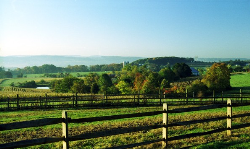
England could lose most of its real countryside within a single generation unless current trends are reversed.
This is the conclusion of a report{1} published by CPRE{2} today (Friday) which considers the major influences on the English landscape and their likely long-term effects on the character and the extent of the countryside.
The report Your countryside, your choice opens with a portrait of England in 2035 in which the countryside as we understand and love it today has all but disappeared from much of England.
'Your countryside, your choice distils the essence of current questions about how best to manage, maintain, develop and preserve the natural environment. I urge everyone to read it, and join in the debate. It's one of the most important of our time.'
Professor Andrew Motion, Poet Laureate
'We cannot continue to consider the countryside as a limitless resource, infinitely able to recover from repeated damage,' said Tom Oliver, CPRE's Head of Rural Policy.
'Whether it's the prospect of a new generation of roads and airports carving up what's left of the countryside, rampant new housing schemes put up with little thought to the environmental consequences, or the abandonment of farming to the tender mercies of world markets alone, the present direction of many official policies is grim. Most initiatives to protect and enhance the countryside are overwhelmed by the scale of the present threats.
COUNTRYSIDE UNDER ATTACK: A DAMAGE ASSESSMENT
Traffic is growing faster on rural roads than in urban areas in England.{3}
Since 1990, 60% of the English landscape has changed in ways which are 'inconsistent' with its traditional character.{4}
Many species of farmland birds are in a precipitous decline. Tree sparrow numbers have declined by 95% since 1970; corn buntings by 85%; turtle doves by 70%; skylarks by 52%.{5}
The proportion of England's land area enjoying truly dark skies fell from 15% to 11% between 1993 and 2000 — a drop of more than a quarter in just seven years.{6}
81,500 farmers and farm workers left the land between 1995 and 2004.{7}
21 square miles of countryside — an area the size of Southampton — is lost to development every year.{8}
The total area of 'tranquil countryside' declined by 20% between 1960s and 1994,{9} and continues to do so.
'What makes this all the more tragic is that so many people care passionately for the countryside, treasure the time they spend in it, and count it as a core part of this country's identity,' Tom Oliver continued.
The report identifies future severe long term threats to the countryside, including:
a greatly expanded house building programme with the land speculation that would go with this;
a huge expansion of road freight distribution and car-dependent development with associated noise and loss of tranquillity;
major airport expansion, both nationally and regionally with associated infrastructure; and
a dramatic decline in farming, leading to ever more polarised land management: either more intensely farmed or abandoned.
All the while, climate change threatens to undermine the long established natural processes at work in the countryside, while our response to the associated extreme weather and increased shortage of water could cause more damage still.
But these threats to the countryside are not inevitable. The report calls for everyone who values the countryside to play their part in ensuring it is still there to be enjoyed by future generations.
CPRE calls on the Government to commit to five broad policy objectives which will help secure the future of the countryside:
redouble efforts to promote efficient use of land for housing, aiming for at least 75% of new housing on previously developed land at an average density of at least 40 units per hectare;
a regional policy which respects environmental capacity, rather than requiring pushing for maximum development in all parts of the country;
encouragement of local food and commodity procurement to reduce dependence on national distribution systems, especially motorways and trunk roads;
continued funding for farmers to manage the countryside both to retain the character of the landscapes and to conserve natural resources such as soil and water;
an end to a policy of predict and provide for national and regional airport capacity.
'Whether it's the individual lifestyle decisions we make, the way our businesses operate or the sort of lead given by government, national, regional and local, we are all responsible. The countryside is for us all. If we want to keep it, all of us have a part to play in its survival for ourselves and for our children,' Tom Oliver concluded.
CPRE is launching a competition to find the most inspiring vision for the future of the English countryside. Find out more about the competition.{10}
